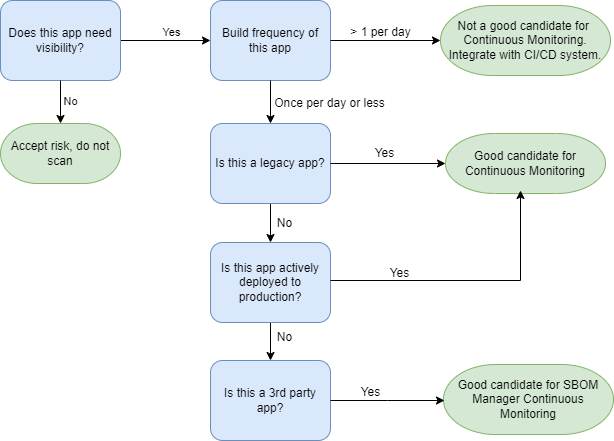Continuous Monitoring Best Practices
Continuous Monitoring (CM) is the capability to automatically check your applications for any new violations every night.
CM needs to be configured to a stage before monitoring will start.
Overview of the Continuous Monitoring (CM) Process
Set CM to a specific stage to monitor
The release and operate stages are the most common
The release stage in the DevOps cycle is where the updated code should have been thoroughly tested and validated, before launch. Setting the CM at the release stage acts as gatekeeping and will inform you of the risks if there are any, to prevent delivery of a product ridden with vulnerabilities.
The operate stage is useful in scenarios involving integrations with deployment tools. Evaluations at this stage will not show up in the dashboard or reporting views.
For more information on selecting a stage to monitor, refer to Usage Suggestions for Each Stage.
Which stage is monitored may be overridden at the organization level
CM notifications are configured on each policy
Focus on critical violations
Send notifications to the appropriate role
CM monitors the most recent Lifecycle evaluation
CM updates the latest report daily
CM creates a new report with every scan
CM may be configured when to run.
Midnight on the installation server is the default
Only new violations will trigger notifications
Use Continuous Monitoring to notify you of newly discovered vulnerabilities
Sonatype data is updated throughout the day
CM will let you know when new vulnerabilities are added to Sonatype data
CM informs you of risk before your next release
Most Effective | Not Effective |
|---|---|
|
|
Understand the impact of your Continuous Monitoring strategy
CM scans a single application at a time to minimize load
A large number of applications may take multiple days to review
Approximately 2500 applications are analyzed per day
99% of scans are completed in less than 2 minutes
95% are completed in less than 30 sec
Consult with Customer Success or Support to increase the CM scan rate
Purge Continuous Monitoring data after 30 days
We recommend setting the data retention for CM to 30 days or less
Reports from Continuous Monitoring accumulate fast when scanned every night
Only the latest report is shown in the UI
Continuous Monitoring Decision Tree
